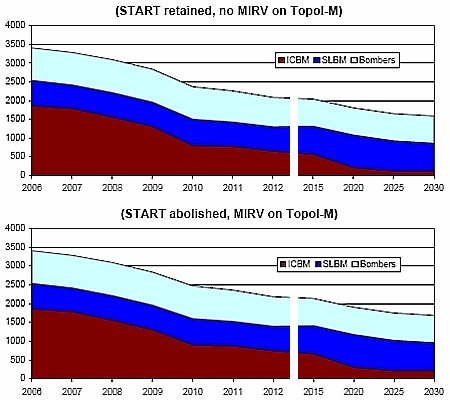(Updated May 9, 2007)

At the beginning of 2007, Russia maintained approximately 5,600 operational nuclear warheads for delivery by ballistic missiles, aircraft, cruise missiles and torpedoes, according to the latest Nuclear Notebook published in the Bulletin of the Atomic Scientists. The Russian Notebook, which is written by Hans M. Kristensen of FAS and Robert S. Norris of NRDC, breaks down the Russian arsenal into roughly 3,300 warheads for delivery by strategic weapon systems and 2,300 warheads for delivery by tactical systems.
In addition to operational warheads, the Notebook estimates that Russia has a stock of roughly 9,400 warheads intended as a reserve or awaiting dismantlement, for a total stockpile of approximately 15,000 warheads.
The Importance of Arms Control (Section below updated May 9, 2007)
Russia and the United States apparently have decided not to extend the START agreement when it expires in 2009. The demise of the treaty will effect the number of warheads deployed on Russia’s ICBMs. Russia has already announced its intention to change the warhead loading on its Topol-M ICBMs.
Had START been extended, Russia’s arsenal of deployed strategic nuclear warheads would likely have declined to approximately 2,040 warheads by 2015 and roughly 1,590 warheads by 2030.
Once the treaty expires, however, and the Topol-M is equipped with three warheads (MIRVs, Multiple Independently Targeted Reentry Vehicles), the arsenal will reach roughly 2,210 warheads in 2015. Deployment of the silo-based Topol-M apparently will finish in 2020, in which case the warhead level will fall to approximately 1,810 warheads by 2030, depending on missile production rates for the mobile version of the Topol-M (see figure below).
|
Russian Strategic Nuclear Warheads 2006-2030 |
 |
| The expiration of START in 2009 will have a significant impact on the future warhead level on Russia’s ICBMs. Beyond 2015, plans for the Russian force structure are uncertain. This projection a total of 84 Topol ICBMs on duty in 2015, and deployment of up to eight Borei-class SSBNs with 6 MIRVs per missile. The lower chart assumes up to 3 MIRVs on both silo and mobile Topol-M. |
Col. Gen. Nikolai Solovtsov, the commander of the Russian Strategic Rocket Forces (SRF), declared in December 2006 and again in May 2007 that Russia will begin to substitute the single warheads on Topol-M ICBMs with multiple warheads after START expires in 2009. He did not specify if that includes both the silo-based and mobile Topol-Ms. If only the silo-based Topol M is MIRVed, then Russia would have some 2,140 strategic warheads in 2015 and approximately 1,690 warheads deployed by 2030.
Current plans will leave Russia with roughly 146 ICBMs by 2015, a significant reduction from the 489 it had at the beginning of 2007, less than half of what the United States plans to have at that time. Russian planning also takes into consideration the Chinese posture, and the U.S. Air Force reported in March 2006 that work may be underway on a new strategic missile that can be deployed in both land-based and sea-based versions.
Russia apparently no longer believes it is necessary to maintain the same number of nuclear warheads as its potential adversaries, but still sees a significant strategic force as necessary. “For us,” President Vladimir Putin said in May 2006, “this idea of maintaining the strategic balance will mean that our strategic deterrence forces must be capable of destroying any potential aggressor, no matter what modern weapons systems this aggressor possesses.”
A Need For Additional Arms Control
Russia is currently, like the United States, making the decisions that will shape the long-term size and composition of its nuclear forces. Seventeen years after the Cold War ended, those decisions are still closely tied to the size and composition of the U.S. nuclear posture.
Putin proposed in June 2006 that START be replaced with a new treaty, and warned that “the stagnation we see today in the area of disarmament is of particular concern.” Although talks are underway with Washington on how to administer the strategic relationship after 2009, START apparently will not be extended.
The governments of both countries urgently need to articulate and decide on a new phase of arms control that will replace the open-ended, ad hoc nuclear planning of today with a framework for how to get to very low numbers with the medium-term goal of concluding the nuclear era.
Background: Russian Nuclear Forces 2007 | Status of World Nuclear Forces |
Satellite imagery has long served as a tool for observing on-the-ground activity worldwide, and offers especially valuable insights into the operation, development, and physical features related to nuclear technology.
This report outlines a framework relying on “Cooperative Technical Means” for effective arms control verification based on remote sensing, avoiding on-site inspections but maintaining a level of transparency that allows for immediate detection of changes in nuclear posture or a significant build-up above agreed limits.
The grant comes from the Carnegie Corporation of New York (CCNY) to investigate, alongside The British American Security Information Council (BASIC), the associated impact on nuclear stability.
Satellite imagery of RAF Lakenheath reveals new construction of a security perimeter around ten protective aircraft shelters in the designated nuclear area, the latest measure in a series of upgrades as the base prepares for the ability to store U.S. nuclear weapons.